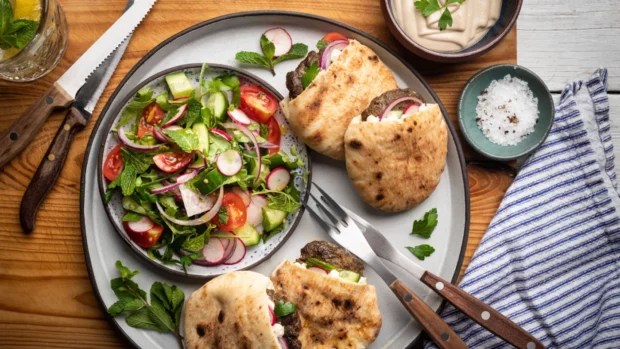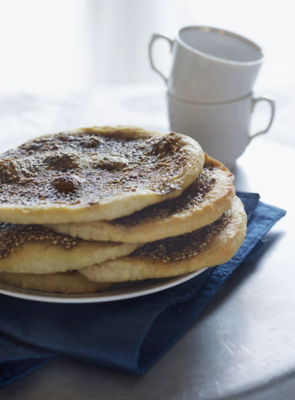Long before I started to cook, I knew how important it was to spice up your life… courtesy of Baby, Scary, Sporty, Ginger, and Posh. Gratuitous Spice Girls mention aside, in terms of spice in the culinary sense, I actually only began to make my own meals when I moved to Tel Aviv after college. I was fortunate enough to live a few blocks away from Shuk HaCarmel—the city’s famous open-air food market—and one of the first spices I added to my pantry was za’atar: a delicious, earthy blend I enjoyed in some of my favorite Middle Eastern dishes.
Truth be told, I never really thought about which spices za’atar contained, or what benefits a shake here and a dash there could offer. But in the spirit of revisiting my early cooking memories and to cover the basics for those who haven’t tried za’atar themselves, I asked Rachael Hartley, RD, LD, dietitian and author of Gentle Nutrition, to share a few essential insights. And later: a few recipes that I hope will inspire you to check out za’atar on your own foodie adventures.
First, what is za’atar?
“Za’atar is a spice mixture made with the herbal plant za’atar—or thyme or oregano, which are closely related—mixed with sesame seeds, sumac, and salt,” Hartley says. She reiterates that za’atar is commonly used in cuisines across the Mediterranean and Middle East, noting that different cultures (and cooks within each culture) typically employ variations to make their own unique blends.
As for the taste, Hartley describes it as “herbal and a bit lemony from the sumac with a nutty, earthy bite from the toasted sesame seeds.” (And with that, my mouth is officially watering.) “My favorite way to use za’atar is as a garnish, to boost the flavor of foods after cooking,” Hartley adds. “A simple way to enjoy za’atar is sprinkled over hummus, giving a simple spread a bit of a flavor boost. It’s also delicious baked over pita, sprinkled over a salad or grain bowl, or on roasted vegetables, grilled meats, or seafood.”
Health benefits of za’atar
“Since za’atar is consumed in small amounts, it’s not an ingredient that provides significant quantities of vitamins and minerals,” Hartley explains. Although a sprinkle of it every so often won’t pack the same nutrient-dense punch as, say, a berry spinach smoothie you sip on daily, that doesn’t mean that the spice blend is void of nutritional value. In fact, quite the opposite. “That said, the herbs in za’atar contain phytonutrients like anthocyanins and flavonoids, which have antioxidant effects,” Hartley continues. “The sesame seeds also provide trace amounts of healthy monounsaturated fats and bone-building minerals like calcium, magnesium, and zinc.”
To date, there’s no research specifically investigating bioactivity of the complete za’atar blend—which is pretty surprising given that it’s been integral to the cuisine of many cultures throughout history. (Not to mention that the Mediterranean diet is among the most-studied eating plans in the world, with heaps of research backing up its potential to help stave off disease, promote longevity, and so on.)
However, per a March 2022 review in the Journal of Functional Foods detailing the individual constituents of za’atar, this spice blend has the potential to promote far-reaching benefits for your health. In short, the combined action of za’atar components—which boast antioxidant, anti-inflammatory, antibacterial, and anti-diabetic effects—can “modulate gut microbiota, oxidative stress, chronic inflammation, and obesity,” yet the exact amount needed to yield such benefits remains unknown, so further studies are needed. At any rate, za’atar certainly looks promising to promote wellness and reduce your risk of developing greater health issues—so do yourself a solid by spicing up your life (err… pantry) with this Middle Eastern staple.
3 delicious recipes that use za’atar
1. Roasted cauliflower with golden raisins

In Hartley’s own za’atar roasted cauliflower recipe, she recommends chopping the cauliflower into even bite-sized pieces; tossing them in olive oil; and sprinkling za’atar, salt, and pepper before roasting them at 400 degrees Fahrenheit for 25 to 30 minutes, flipping the florets halfway through. Once they’re nice and crispy, toss in golden raisins. Hartley notes that they’re a particularly rich source of kaempferol, “an antioxidant flavonoid which has been linked to a reduced risk of cardiovascular disease and cancer,” as well as a good source of fiber, potassium, and iron.
Get the recipe: Za’atar roasted cauliflower with golden raisins
2. Israeli burgers with fattoush salad

Celebrity chef, cookbook author, and entrepreneur Jamie Geller sells her own za’atar blend, which she uses in dozens of her kosher recipes like this one for burgers and fattoush salad. The burgers couldn’t be easier to make as they only call for ground beef or chicken, za’atar, and olive oil. Meanwhile, sumac and lemon lend brightness and acidity to the fattoush salad—a staple in Levantine cuisines and a personal favorite of mine—which she recommends packing into toasted mini pitas once the burgers are golden brown on both sides and ready to enjoy.
Get the recipe: Israeli burgers with fattoush salad
3. Lebanese za’atar

In the mood to make your own za’atar blend from scratch? Check out this traditional old-world Lebanese version of za’atar from chef and cookbook author Julie Ann Sageer, aka Julie Taboulie. It calls for just four ingredients: dried wild thyme or Greek oregano, sumac spice, sesame seeds, and sea salt. Finely grind the wild thyme (or oregano) and sumac spice before mixing in the toasted sesame seeds and salt. Sageer writes that she uses this simple yet delicious spice mix for delicacies like man’oushe (flatbread), labneh (strained yogurt), and Shanklish (yogurt cheese balls).
Get the recipe: Lebanese za’atar
Our editors independently select these products. Making a purchase through our links may earn Well+Good a commission.
